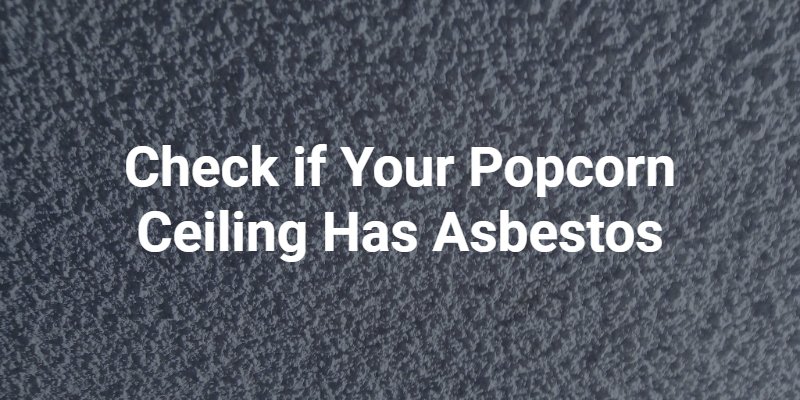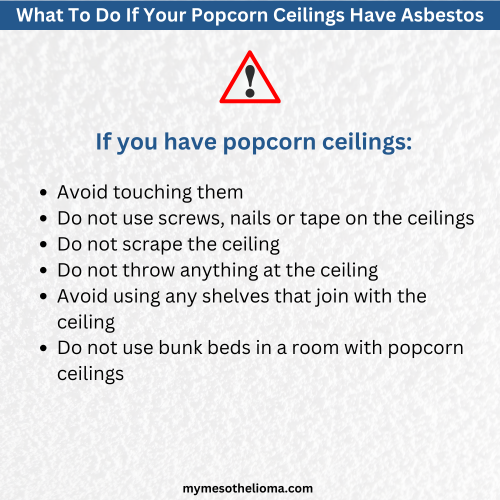Asbestos is a dangerous substance that was widely used to manufacture building materials in the 1800s and 1900s, before it was confirmed as carcinogenic (cancer-causing) and regulated in the United States. One of the many construction materials that used asbestos as an ingredient is textured ceiling sprays, including “popcorn” ceilings. If your home or workplace has popcorn ceilings, you may be at risk of exposure to asbestos and related health problems.
The History of Asbestos in Popcorn Ceilings and Textured Sprays
Asbestos is a group of six naturally occurring minerals. Asbestos has traits that made it a popular addition to building and construction materials, such as resistance to heat and corrosion. It was also durable and cost-effective. Prior to the Environmental Protection Agency’s ban on asbestos in the 1980s, many homes and buildings were constructed using asbestos. This includes cements, adhesives, insulation, floor and ceiling tiles, and textured sprays and paints. Estimates place the amount of asbestos present in many popcorn ceilings between 1 and 10 percent.
Today, many older homes and buildings still contain popcorn ceilings that are contaminated with asbestos. For the most part, these ceilings are safe if they are not touched, damaged or disturbed. If particles of asbestos are released into the air, however, the asbestos could be inhaled and cause a variety of illnesses and diseases, including mesothelioma. This is a rare and aggressive form of cancer. If a textured ceiling spray is scraped, scratched, drilled into or otherwise disturbed, it can pose a risk of asbestos inhalation or ingestion.

What Are the Dangers of Asbestos in Popcorn Ceilings?
Asbestos causes health problems by irritating and inflaming the inner tissues of the body over a long period of time. The average latency period for asbestos-related diseases is 20-60+ years. In the years that microscopic asbestos particles and fibers are lodged inside of the body, they can irritate surrounding tissues. This can eventually result in the development of cancer cells, tumors, scar tissue, a buildup of fluid and other serious health issues.
Health problems that are associated with exposure to asbestos include:
- Mesothelioma – cancer of the mesothelium, or the protective membrane that surrounds many of the internal organs.
- Asbestosis – a buildup of scar tissue and inflammation that impacts the function of the lungs and can prevent them from expanding.
- Lung cancer – cancer of the lungs caused by scarring that can result in DNA cell changes and the development of cancer cells.
- Other cancers – exposure to asbestos has been linked to other types of cancers, including ovarian cancer, stomach cancer, laryngeal cancer and pharyngeal cancer.
- Pleural plaques or thickening – breathing problems caused by thickened lung tissues or “plaques” – calcified scar tissue.
These illnesses can occur if an individual inhales or ingests asbestos fibers even once. The National Cancer Institute states that there is no “safe” amount of asbestos exposure. Prolonged exposure to asbestos, however, increases the risk of mesothelioma and other illnesses. Living in a home with contaminated popcorn ceilings for an extended period of time can come with higher odds of an asbestos-related condition.
How to Tell if Your Popcorn Ceiling Has Asbestos
Protecting yourself from asbestos in popcorn ceilings starts with determining if the ceilings where you live or work contain this toxic mineral. Not all popcorn ceilings contain asbestos. The type of asbestos that was used to create popcorn and textured ceiling sprays is chrysotile asbestos. This was the most frequently used type of asbestos for manufacturing purposes because its curly texture can be woven. Unfortunately, it is also the most dangerous form of asbestos.
You typically cannot see asbestos with the naked eye. If your home was built before the 1990s and your ceilings have texture, such as the popcorn or cottage cheese effect or a visibly pockmarked surface, assume they have asbestos until it is proven otherwise. Treat your popcorn ceilings with care. Do not scrape them, sand them or attempt to remove them yourself. The only safe way to tell if your popcorn ceiling has asbestos is by hiring a licensed asbestos professional to test a sample.
Do not attempt to test for asbestos yourself using an at-home testing kit. While this may cost less than hiring a professional, it could put you at risk of asbestos exposure if you make a mistake. A certified asbestos abatement contractor will carefully collect a sample to test for asbestos without putting dust into the air. If the test comes back positive for asbestos contamination (more than 1 percent of asbestos), you may wish to remove the popcorn ceiling or spray-on ceiling texture.

Safe Asbestos Removal From Popcorn Ceilings
Licensed asbestos contractors are the only people who should check for and deal with asbestos in popcorn ceilings. Asbestos abatement professionals will have the proper tools, protective gear and training to handle asbestos-containing materials without risking the health of those living in the building. An ordinary face mask will not protect you from asbestos exposure. You need professional gear, as well as sealants to remove asbestos fibers without creating dangerous asbestos dust.
If you wish to remove your popcorn ceilings, an asbestos company will start by emptying the home of people and pets. All furniture will be removed from where the removal will take place to avoid contamination. Air conditioning systems will be turned off to prevent asbestos dust from being circulated throughout other parts of the house.
The asbestos professionals will build a containment area with covers to help contain asbestos debris. Then, they will remove the popcorn ceilings using protective clothing and the proper equipment to avoid exposure to asbestos. Finally, the company will bring the asbestos-containing materials to an official disposal site.
Popcorn Ceilings Asbestos FAQs
What is the Likelihood of Finding Asbestos in Popcorn Ceiling?
If your home was built between the 1950s and 1980 and has popcorn ceilings, it’s likely that asbestos is present. Homes constructed between 1980 and 1990 may also have asbestos in popcorn ceilings, though the likelihood decreases with newer construction.
Do All Popcorn Ceilings Have Asbestos?
No, not all popcorn ceilings contain asbestos.
How to Test for Asbestos in Popcorn Ceiling?
The best way to make sure your ceiling does or does not have asbestos is having it tested professionally. You can take a sample of the popcorn texture from anywhere in the home and bring it to a local lab.
Exposed to Asbestos From Popcorn Ceilings? Help Is Available
If you have been diagnosed with an illness caused by exposure to asbestos and were around popcorn ceilings at any time in your life, you may have grounds to file a lawsuit.
Holding someone responsible for the contaminated ceilings that caused your disease could help you and your family move forward with the answers and financial compensation that you need.
Find out if you have grounds for an individual lawsuit, product liability claim, workers’ compensation claim, asbestos trust fund claim or another type of legal action for contaminated popcorn ceilings by consulting with an attorney. The team of asbestos lawyers at Bailey & Glasser, LLP have years of experience representing clients nationwide in asbestos and mesothelioma claims. We can help you understand and preserve your rights as a victim of asbestos exposure from popcorn ceilings. Learn more when you call (866) 871-7971.

